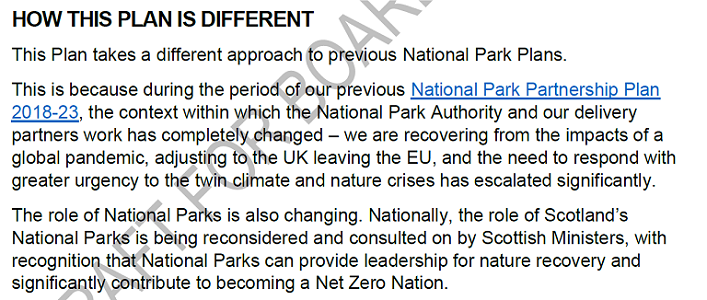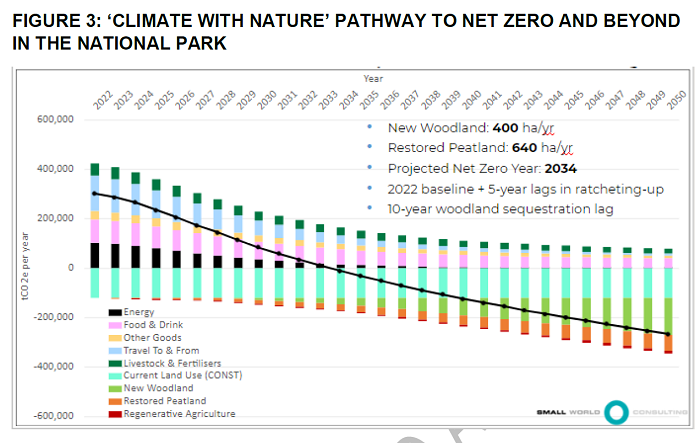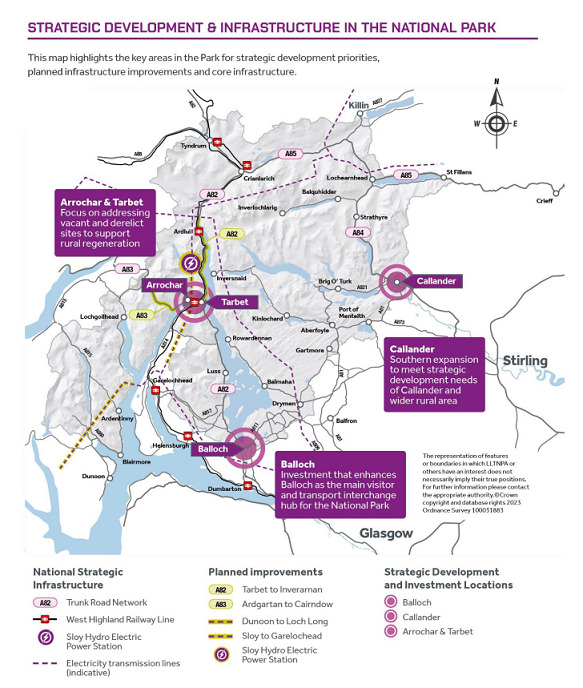
I had not attended a Loch Lomond and Trossachs National Park Authority (LLTNPA) board meeting in person since before the Covid lockdown but on 11th December once again took the train to Balloch.
Having just written a post on The fundamentally useless National Park Authority and its useless National Park plan it was very decent of the LLTNPA’s head of communication to welcome me when I walked into the meeting room at Lomond Parish Church, the only member of the public to attend. She has a great sense of humour and while helping me to find somewhere to plug in my laptop said something to the effect that “I expect we will hear if we have got something wrong!”.
The LLTNPA’s communications team is nothing if not professional and, as several Board Members said during the meeting, have done a great job presenting the new National Park Partnership Plan (NPPP) and making the contents readable. The problem, which is not their fault, is they can only communicate the content they have been given and that, as this post explains, is not going to change anything for the better.
A NPPP of green sounding aspirations but unresourced
As is usual with LLTNPA board papers, while there were some mostly gentle criticisms and suggestions from Board Members, nothing meaningful in the draft NPPP was amended. There was, however, a very important discussion at the end.
Ronnie Erskine, chair of the risk management and audit committee who stated he was very supportive of the objectives set out in the plan, identified a major risk: that without resources the LLTNPA would fail to deliver the aspirations set out in the document. He suggested that the LLTNPA Board ,while commending the NPPP to Lorna Slater, the Minister responsible, should amend the recommendation to point out that the delivery of the objectives and outcomes would depend on resources.
In response, the LLTNPA Chief Executive, Gordon Watson, said that the resources the Park needed would be subject to annual negotiations with the Scottish Government and form part of the corporate plan not the NPPP. This ignored the fact that the NPPP is supposed to be a Partnership Plan, with other public authorities responsible for some of its objectives, also needing resources. The NPPP should be an opportunity to get other Scottish Government departments (e.g. Scottish Forestry), non-departmental public boards (e.g. NatureScot) and local authorities to commit the necessary resources. If the LLTNPA itself can’t or won’t do this, it is quite clear no-one else will.
Martin Earl, the Tory councillor nominated by Stirling, led the fight back on behalf of Gordon Watson. His argument was that the NPPP was very strategic, should only set out broad strategic objectives and that resources were best dealt with elsewhere. In other words, the NPPP is not a plan but yet another unresourced strategy. Ronnie Erskine did get some support, mainly from the locally elected members and the two Argyll and Bute Councillors but, in a process that ignored normal decision-making protocols on how to amend motions, was easily outvoted by all the other Scottish Government nominees on the Board..
The provides a good example of why the Scottish Government’s current proposals to reduce local representation and increase the number of Ministerial appointments on National Park Boards will make National Parks worse, not better. Few national appointees are prepared to bite the hand that feeds them.
A NPPP that fails to deliver Scottish Government aspirations for National Parks

In its recent consultation on Tackling the Nature Emergency (see here) the Scottish Government asked two important questions about National Parks and their Plans:
Question 7a: Do you agree that the purpose of National Park authorities should be amended in order to emphasise the important leadership role that National Park authorities need to play in restoring nature and in mitigating and adapting to climate change?
and,
Question 7i: Do you agree that the duty on public bodies operating within National Parks should be strengthened so they have an obligation to support and contribute to the implementation of National Park Plans rather than having regard to these plans?
Instead of leading the way, the LLTNPA’s NPPP has generally adopted Scottish Government targets that apply to Scotland as a whole. This came out in the discussion when certain Board Members remarked that the graph on carbon emissions looked quite ambitious and questioned how the energy reductions shown on the graph in black would come about for domestic properties:

The answer from Gordon Watson was that the data that informed the graph was taken from the Scottish Government’s own targets for reducing carbon emissions! Targets that the Scottish Government has consistently failed to meet. Why and how the LLTNPA will meet them was not explained.
In the case of deer numbers (see here), the NPPP does not even adopt the Scottish Government’s target of 2 per deer per square kilometre in priority woodland and 10 outside (except for the Cairngorms where it will be 5-8). Instead, the LLTNPA’s NPPP aims to
“Achieve nationally recognised target levels of average deer densities – currently a maximum of 5 deer per km2 in woodland and a maximum of 10 deer per km2 on the open hill”
No doubt when someone realises the mistake, the target will be tweaked from five deer per square kilometre in woodland to two in “priority woodland”.
 Were the NPPP to have applied the Scottish Government’s target of two deer per square km target for “priority woodland” to its “woodland expansion priority areas” (see map above) the impact could potentially have been quite radical. The problem of course is its impossible to maintain populations of two deer per square kilometre next door to populations of 10 per square kilometre without miles and miles of expensive deer fencing that only works for a few years. The LLTNPA’s contains not a single mention of fencing, quite a contrast to the Cairngorms National Park Authority’s NPPP which contains a presumption against it!.
Were the NPPP to have applied the Scottish Government’s target of two deer per square km target for “priority woodland” to its “woodland expansion priority areas” (see map above) the impact could potentially have been quite radical. The problem of course is its impossible to maintain populations of two deer per square kilometre next door to populations of 10 per square kilometre without miles and miles of expensive deer fencing that only works for a few years. The LLTNPA’s contains not a single mention of fencing, quite a contrast to the Cairngorms National Park Authority’s NPPP which contains a presumption against it!.
The one board member who suggested that reducing grazing pressure was the key to woodland expansion, the local member for Balloch and former biology teacher Sid Perrie, was given no support by other board members.
The targets in the plan show that far from showing leadership, the LLTNPA’s main aspiration is to be “average”.
As for the Scottish Government’s proposal that the National Park legislation should be amended so that Public Authorities have a duty to support and contribute to the NPPP, there seems little point if all the NPPP does is repeat Scottish Government targets that already apply to other public authorities.
The LLTNPA’s NPPP is not a plan for land-use but is a plan for development purposes
“The high-level nature of the Plan meant that many draft objectives, policies and actions were screened out from the SEA [Strategic Environmental Assessment]. This is mainly due to the strategic level of the draft Plan and that it does not specify locational detail. Further assessments will be made of more detailed plans, such as Local Development Plan and at project level, to ensure a more appropriate and informed assessment can be undertaken once the locations for the actions are identified.” (Para 4.27 of the report to the Board accompanying the draft NPPP).
This helps explain why there is nothing the NPPP describing where nature will be restored, not even in areas like the Great Trossachs Forest National Nature Reserve where this has been agreed for quite some time. The NPPP is, when it comes to restoring nature and reducing carbon emissions, a vague strategy not a plan. That is not going to tackle any emergency.
Interestingly, however, completely different reasoning is applied in the NPPP to developments. The location of major developments is specified:

The NPPP has been designed to provide the overarching spatial framework which will be developed in a new Local Development Plan. The explanation for this appears to be that “It is intended the content within the National Park Partnership Plan will also serve the function of being a Regional Spatial Strategy for the National Park. A Regional Spatial Strategy is a new type of Plan introduced by the Planning (Scotland) Act”.
This means that the NPPP gives high level endorsement to the proposed Flamingo Land development at Balloch and the Moulsdale development at Tarbet (see here), while saying nothing about where other forms of land-use needs to change to benefit nature.
The fundamental confusion about the status of the NPPP, whether its a strategy or plan, is also shown by the way the LLTNPA has failed to incorporate into it the proposals that had formed part of its draft Outdoor Recreation Plan (ORP). The LLTNPA scrapped the ORP after extensive public consultation claiming it would be covered by the NPPP (see here). It hasn’t. If it was not appropriate to include the specific proposals contained in the ORP in the NPPP, then the logical implication is the LLTNPA now needs to commit to producing a separate ORP. There was no mention or discussion of this glaring hole at the board meeting.
Given the extensive legal rights of landowners to do as they wish, getting private landowners to change the way they use the land is very difficult. There were references in the Board discussion to the challenges of persuading landowners to do the right thing and Cllr Sinclair made some excellent points about the need for the rural subsidy regime to change if this is to happen.
Strangely, however, there was no mention of the potential for change by Forest and Land Scotland (FLS), by far the largest land owner in the National Park which manages land on behalf of Scottish Ministers. If there was the political will, the industrial forestry as practised by FLS in the National Park, which has generally been disastrous for both nature and carbon emissions, could be changed. Instead, however, of taking the lead and committing to change their disastrous 2019 Trees and Woodland Strategy (see here), which allowed FLS to do as it please, the NPPP effectively allows more of the same. If the NPPP cannot even change how public land is managed for climate and nature, it might as well be scrapped and the LLTNPA give up the pretence of trying to change anything.
But not so useless for financial interests…………….
While promising almost nothing for nature, climate change or the public’s right to enjoy the National Park, the NPPP does open the door to private financial interests (as well as developers):

The big idea is that the alleged lack of public resources (the UK has plenty of money, its just being spent on things like armaments) will be replaced by ethical private investment and that is how the LLTNPA will meet its targets.
Why any financial institution or rich person would invest in restoring nature is not explained, but the hope appears to be that financial returns could be generated as with the Peatland and Woodland Carbon Codes. There was no critical discussion of this key part of the NPPP at the Board Meeting, despite the increasing evidence of the disastrous consequences of the Woodland Carbon Code both for carbon emissions (see here for example) and land prices (see here).
As I argued in my post on the Scottish Government’s biodiversity strategy (see here), if we want to address the collapse of nature in Scotland we need to address the fishing, forestry and farming markets and the sporting land-use that bears primary responsibility for this. While the collapse of nature in the National Park since it was created is now openly acknowledged in the NPPP, the LLTNPA has failed to analyse why this has happened. Instead, it is relying on the financial interests behind those same markets that have been destroying the planet and humanity with it to restore all the destruction. That is naive and a forlorn hope.
It also marks a betrayal of the idea that our public authorities primary role is to serve the public interest, rather than private interests. Instead of calling for greater regulation of deer numbers for example, as Douglas MacMillan argued earlier this week (see here), the LLTNPA is working behind the scenes (as I will show in future posts) to support and facilitate private interests, whether those of landowners or investors. Neo-liberal thinking now permeates everything the LLTNPA does. The NPPP may appear to most intents and purposes vacuous and is unlikely to do anything to deliver the LLTNPA’s four statutory aims but actually what is does do is open the door to major developers and financial speculation in land. The NPPP is therefore very dangerous and people need to call on Lorna Slater to reject it.
Colourful graphs from the Scottish Govt. (as above – Climate with Nature / Fig.3) are as much use, least of all to the LLNP, as the idea of a chocolate teapot filled with water boiled by a hot wind – impossible to comprehend & ultimately part of the fantasy politics of ‘net zero’.
All such a phrase means is that on balance, our output of CO2 & related fossil fuel toxins will be intentionally countered by all the lovely sounding woodlands and the confusions of separating land use, agricultural emissions etc. It means, surely, spending hours on creating abstract papers & hours of fruitless discussion primarily to make those writing and discussing feel as if they’re doing their bit, while emissions are still an issue?
By having no real plan, other than some of the rather airhead statement from Scottish Greens – https://greens.scot/blog/climate-change-wont-wait-for-pieces-to-fall-into-place – adorned by SNP hyperbole – https://www.heraldscotland.com/politics/23601367.climate-change-target-missed-first-year-snp-green-government/ – there is no real evidence of action and certainly no real money to back it up other than the grants (income streams for nowt) given to landowners who claim to be ‘doing their bit’ – https://www.fwi.co.uk/business/payments-schemes/carbon-credits-explained-long-term-income-option-for-farmers – the Park’s paper stands as disingenuous as nominating Sturgeon for the Nobel Prize for political states(woman)ship.
Net zero is a con term: either we are going to eliminate carbon emissions (in reality not just in contrived statistics) or we’re not and any syrup-coated papers which avoid the hard issues of genuine alternatives that may have an iota of impact backed by cash to help get us there (nuclear & incineration – both deemed a ‘no no’ by the SNP and many local communities) is worthless both in the National Park & Nationwide.
…and if I may put my head above the parapet of blinkered reality, I’d say we have as much hope of making any significant impact on the environmental & species destruction the Human animal has created, since the mid- 18th century (toxic emissions & waste have been flowing into the air, fresh waters and seas since early industrialisation), as Putin becoming World Peace envoy. Our efforts should surely be to find ways to help future generations manage life on Earth as it deteriorates not dabbling with what are in effect micro-projects which are so wound up in committees and strategic papers as to be part of the problem.
Great article Nick. May I also add that the Scottish Land Commission, whose main aim was meant to be facilitating the transfer of land ownership from wealthy absentee investors to local communities, is also apparently acting as conduit for private absentee investors to purchase land in Scotland. The justification would appear to be the (forlorn) hope that somehow local communities will benefit from ‘noblesse oblige’ e,g. crumbs from the table.
The appointment of Mike Russell, erstwhile SNP President, to the role of Chair of the SLC does not bode well for the organisation either… as a government minister a few years ago he was trying his best to sell the forests owned by us, the public, and managed on our behalf by FLS, to American corporate ‘investors’. Bewildering and scary times … and the worst may yet be to come.
Detail I was unaware of. Thanks
As it is Christmas I thought I would indulge myself with a second comment on this article Nick if I may. I refer to the photo at the top. While I think it is laudable to recognise that non-white Scots are living in and enjoying the Park (as they should) is it worth pointing out that the least inclusive group of stakeholders (the most white and the most male – almost exclusively so) are the landowners of LLTNP? Has the LLTNP got any worthwhile policies to diversify land ownership? As I see it identity politics is increasingly being deployed by those with the ‘Power’ to suit their own ends, which is to support social identity as an issue for the masses. Their true goal though is avoid attention falling on the retention of all power by the ‘white landed establishment’. https://www.researchgate.net/publication/225511411_Conservation_with_a_Gun_Understanding_Landowner_Attitudes_to_Deer_Hunting_in_the_Scottish_Highlands